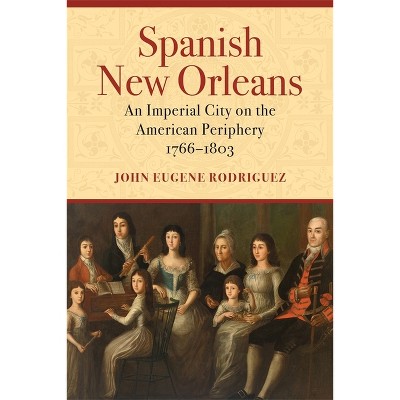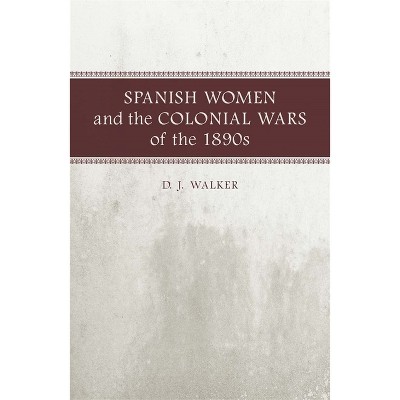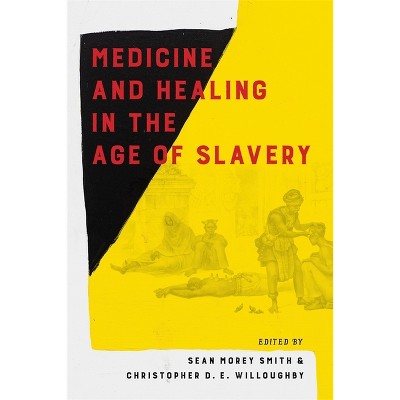$44.92 sale price when purchased online
$45.00 list price
Target Online store #3991
About this item
Highlights
- Constructing the Spanish Empire in Havana examines the political economy surrounding the use of enslaved laborers in the capital of Spanish imperial Cuba from 1762 to 1835.
- About the Author: Evelyn P. Jennings is the Margaret Vilas Professor of Latin American History at St. Lawrence University in New York.
- 298 Pages
- Social Science, Slavery
Description
About the Book
""Constructing the Spanish Empire in Havana" examines the political economy surrounding the use of enslaved laborers in the capital of Spanish imperial Cuba from 1762 to 1835. In this first book-length exploration of state slavery on the island, Evelyn P. Jennings demonstrates that the Spanish state's policies and practices in the ownership and employment of enslaved workers after 1762 served as a bridge from an economy based on imperial service to a rapidly expanding plantation economy in the nineteenth century. The Spanish state had owned and exploited enslaved workers in Cuba since the early 1500s. After the humiliating yearlong British occupation of Havana beginning in 1762, however, the Spanish Crown redoubled its efforts to purchase and maintain thousands of royal slaves to prepare Havana for what officials believed would be the imminent renewal of war with England. Jennings shows that the composition of workforces assigned to public projects depended on the availability of enslaved workers in various interconnected labor markets within Cuba, within the Spanish empire, and in the Atlantic world. Moreover, the site of enslavement, the work required, and the importance of that work according to imperial priorities influenced the treatment and relative autonomy of those laborers as well as the likelihood they would achieve freedom. As plantation production for export purposes emerged as the most dynamic sector of Cuba's economy by 1810, the Atlantic networks used to obtain enslaved workers showed increasing strain. British abolitionism exerted additional pressure on the slave trade. To offset the loss of access to enslaved laborers, colonial officials expanded the state's authority to sentence deserters, vagrants, and fugitives, both enslaved and free, to labor in public works such as civil construction, road building, and the creation of Havana's defensive forts. State efforts in this area demonstrate the deep roots of state enslavement and forced labor in nineteenth-century Spanish colonialism and in capitalist development in the Atlantic world. "Constructing the Spanish Empire in Havana" places the processes of building and sustaining the Spanish empire in the imperial hub of Havana in a comparative perspective with other sites of empire building in the Atlantic world. Furthermore, it considers the human costs of reproducing the Spanish empire in a major Caribbean port, the state's role in shaping the institution of slavery, and the experiences of enslaved and other coerced laborers both before and after the beginning of Cuba's sugar boom in the early nineteenth century"--Book Synopsis
Constructing the Spanish Empire in Havana examines the political economy surrounding the use of enslaved laborers in the capital of Spanish imperial Cuba from 1762 to 1835. In this first book-length exploration of state slavery on the island, Evelyn P. Jennings demonstrates that the Spanish state's policies and practices in the ownership and employment of enslaved workers after 1762 served as a bridge from an economy based on imperial service to a rapidly expanding plantation economy in the nineteenth century.
The Spanish state had owned and exploited enslaved workers in Cuba since the early 1500s. After the humiliating yearlong British occupation of Havana beginning in 1762, however, the Spanish Crown redoubled its efforts to purchase and maintain thousands of royal slaves to prepare Havana for what officials believed would be the imminent renewal of war with England. Jennings shows that the composition of workforces assigned to public projects depended on the availability of enslaved workers in various interconnected labor markets within Cuba, within the Spanish empire, and in the Atlantic world. Moreover, the site of enslavement, the work required, and the importance of that work according to imperial priorities influenced the treatment and relative autonomy of those laborers as well as the likelihood they would achieve freedom. As plantation production for export purposes emerged as the most dynamic sector of Cuba's economy by 1810, the Atlantic networks used to obtain enslaved workers showed increasing strain. British abolitionism exerted additional pressure on the slave trade. To offset the loss of access to enslaved laborers, colonial officials expanded the state's authority to sentence deserters, vagrants, and fugitives, both enslaved and free, to labor in public works such as civil construction, road building, and the creation of Havana's defensive forts. State efforts in this area demonstrate the deep roots of state enslavement and forced labor in nineteenth-century Spanish colonialism and in capitalist development in the Atlantic world. Constructing the Spanish Empire in Havana places the processes of building and sustaining the Spanish empire in the imperial hub of Havana in a comparative perspective with other sites of empire building in the Atlantic world. Furthermore, it considers the human costs of reproducing the Spanish empire in a major Caribbean port, the state's role in shaping the institution of slavery, and the experiences of enslaved and other coerced laborers both before and after the beginning of Cuba's sugar boom in the early nineteenth century.Review Quotes
At last! A book that breaks away from scholars' infatuation with slavery and the plantation complex. Evelyn P. Jennings's meticulous study will do much to revise our understanding of slavery and slave society in eighteenth-century Cuba by establishing the importance of the two primary actors: the Spanish military and the bureaucratic state.--Sherry Johnson, author of "Climate and Catastrophe in Cuba and the Atlantic World in the Age of Revolution"
Relying on a wide array of primary and secondary sources, Jennings's fascinating narrative submerges the reader into a world of war, injustice, and enslavement, where Cuban elites, planters, and merchants are shown evolving from their local, somehow contained environments into transnational actors, fully committed to the development of a lucrative sugar industry based on African slave labor.--Manuel Barcia, author of "The Yellow Demon of Fever: Fighting Disease in the Nineteenth-Century Transatlantic Slave Trade"
About the Author
Evelyn P. Jennings is the Margaret Vilas Professor of Latin American History at St. Lawrence University in New York.Dimensions (Overall): 9.0 Inches (H) x 6.0 Inches (W) x .81 Inches (D)
Weight: 1.34 Pounds
Suggested Age: 22 Years and Up
Number of Pages: 298
Genre: Social Science
Sub-Genre: Slavery
Publisher: LSU Press
Format: Hardcover
Author: Evelyn Jennings
Language: English
Street Date: December 16, 2020
TCIN: 88994331
UPC: 9780807173947
Item Number (DPCI): 247-58-1217
Origin: Made in the USA or Imported
Shipping details
Estimated ship dimensions: 0.81 inches length x 6 inches width x 9 inches height
Estimated ship weight: 1.34 pounds
We regret that this item cannot be shipped to PO Boxes.
This item cannot be shipped to the following locations: American Samoa (see also separate entry under AS), Guam (see also separate entry under GU), Northern Mariana Islands, Puerto Rico (see also separate entry under PR), United States Minor Outlying Islands, Virgin Islands, U.S., APO/FPO
Return details
This item can be returned to any Target store or Target.com.
This item must be returned within 90 days of the date it was purchased in store, shipped, delivered by a Shipt shopper, or made ready for pickup.
See the return policy for complete information.












